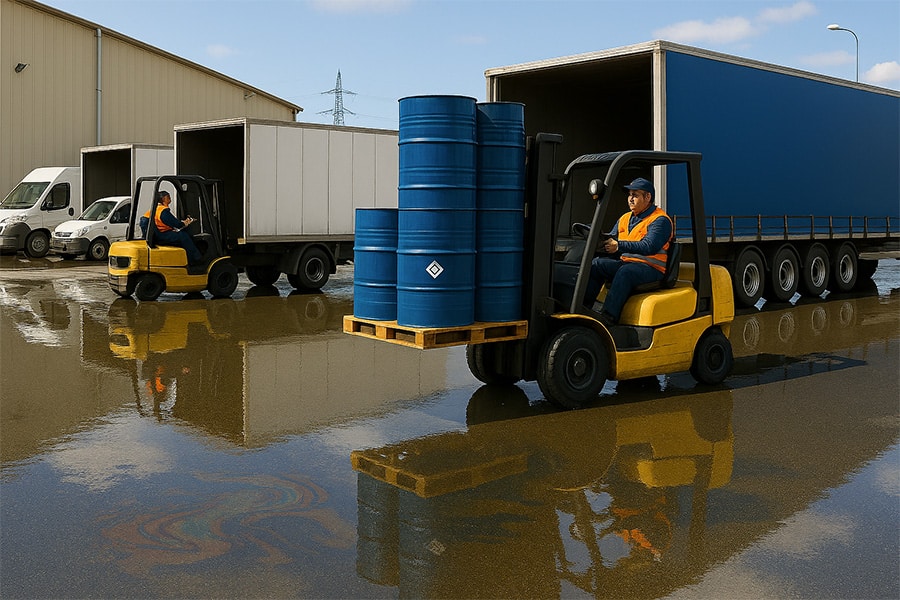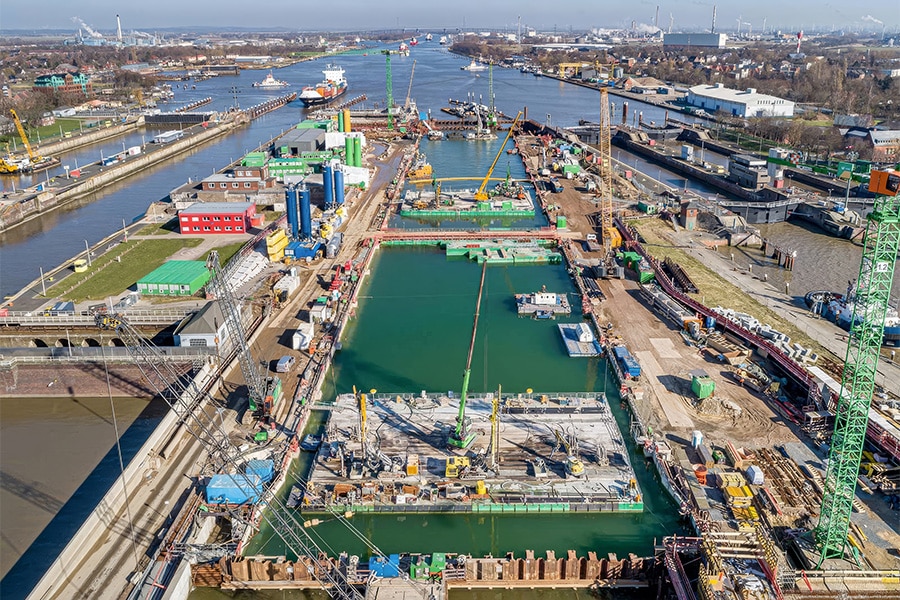
New De Poel pumping station: feat of engineering in Zeeland's polders
In less than a year and a half, the old De Poel pumping station in 's-Heer Abtskerke, near Goes in Zeeland, was replaced by an entirely new and larger pumping station. A daring feat, because in addition to the increased pumping capacity, it now includes two fish-friendly pumps, a fish passage and a backflow pipe. The new pumping station should ensure that Goes and the surrounding area will have dry feet for the next 100 years.
"Unique to the new construction of the polder pumping station is that very many facets were involved," says Noud IJzerman, project coordinator at Van Boekel Bouw & Infra. The construction company was the main contractor on the project. "A whole building pit construction had to be made. In addition, the pumping station is next to the steam train line between Goes and Borssele, the pumping capacity was increased and the new pumping station is fish-friendly. All these components individually brought the necessary challenges." Van Boekel is no stranger when it comes to new construction and renovation of pumping stations. Among other things, they are involved in the Four Polder Pumping Stations project of Hoogheemraadschap van Rijnland, they have worked on behalf of Waterschap Brabantse Delta on making a number of waterworks in West Brabant fish-friendly, and they are responsible for the renovation of Poldergemaal Besjeslaan in Leiden and make the framework agreement Polder Pumping Stations for Hoogheemraadschap van Rijnland.

Need for new pumping station
Van Boekel Bouw & Infra built the De Poel pumping station in Zeeland on behalf of the Scheldestromen Water Board. The main reason for building the new pumping station was that the capacity of the old station no longer met the current standards of Water Management 21st century. The new pumping station should contribute to a robust and future-proof water system. "To make the water system also resistant for the next 100 years, expansion of the capacity was necessary," explains Marnix van den Manacker, project manager at Scheldestromen Water Board.
"The subsurface drainage in the old situation consisted of two auger pumps. This auger pumping station proved vulnerable in the past. If the water level in the upper pumping station became too high, the auger could not discharge the water and it could even flow back over the augers." Should Waterschap Scheldestromen do nothing about the existing situation, various problems could arise. Think of too high (ground) water levels with problems for agriculture, inundation of agricultural plots in extreme precipitation situations, problems with the supply and discharge of surface water, but also problems with water quality. The new pumping station has two pumps that can discharge 270 m3 of water per minute, an increase of 50 m3 per minute over the old pumping station. "This allows us to manage and discharge the water level even in extreme situations," Marnix said. The project involved about €9 million, of which €3,350,000 in E-POP-3 funding was received.

Robust water system
Besides increasing capacity, there was another important task: contributing to the clean water goals of the Water Framework Directive (WFD). Marnix: "We want to create an ecologically robust water system with sufficient possibilities for fish migration. In the old situation, fish migration was not possible. So the two new pumps are fish-friendly and the two old pressure pipes have been given a new function. One pipe is used as a backflow pipe so we can intake water in times of drought. The other pipe is now being used as a fish passage with a fish elevator so that fish that enter the polder from the Westerschelde via Maelstede pumping station can now swim further towards the surroundings of Goes. This mainly concerns eel (glass eel) and three-spined sticklebacks that enter the polder from the sea. Through the fish passage, fish such as perch, zander, roach, giebel and carp can also move between the polders." A special feature of the fish passage is that it is a so-called fish elevator. Where a pumping station normally blocks the swimming route for fish, the fish elevator now creates a continuous lure flow on the side of both water catchment areas. It also contains a built-in camera that allows fish to be recognized and counted.

Design
The water board had a preliminary design for the new building. Van Boekel further developed this into a final design. Noud: "The pumps are essential for a polder pumping station. Their size is fixed, around which you design the concrete shell. It is very easy to make a large building so that you have all the space you need, but that also involves a lot of expense. The trick is to come up with a compact building that everyone is happy with and where there is a good balance between the area needed and the cost." The final result is a sustainable building that fits in well with its surroundings. Marnix: "It has become a sober but beautiful building. While the old pumping station was still constructed of masonry bricks, for the new pumping station we chose a façade of wood and a sedum roof."
Railroad
The new construction project included several challenges as Noud told us at the beginning of this story. As far as he was concerned, though, the biggest challenge was the railroad line. "The railroad line is managed by museum railway company Stoomtrein Goes-Borssele. We were given a month to lay the discharge lines. The track itself was removed by the museum railway company. We designed the foundation piles to be outside the track so that we could install them at an earlier stage. That saved a lot of time. Then we started the excavations. That was in November 2023, a very wet period. With all that water, we definitely ran fighting at the bottom of the construction pit."
Unexpected hard primer
Speaking of the building pit, while excavating the inflow structure, they unexpectedly encountered a very hard layer including oysters and shells. Noud: "Despite thorough preliminary research, this came as a surprise to us. As a result, we had to adjust the method of excavation. Instead of hosing down the soil and sucking it into a separate sludge basin, we used a crane. To prevent it from hitting the foundation piles, we also deployed additional culverts to supervise the excavation."
Collaboration
Work began in March 2023, and the new pumping station was commissioned in June 2024. Both parties are very pleased with the cooperation. "It is nice working together with Waterschap Scheldestromen," says Noud. "Together we have succeeded in putting down a well-functioning pumping station in a relatively short period of time. We as the main contractor enjoyed working on this project." Marnix is also proud of the final result. "With a small club we got the job done within a foreseeable time. Meanwhile, the two pumps have already run for over 500 hours each. They will certainly prove their service in the years to come."




